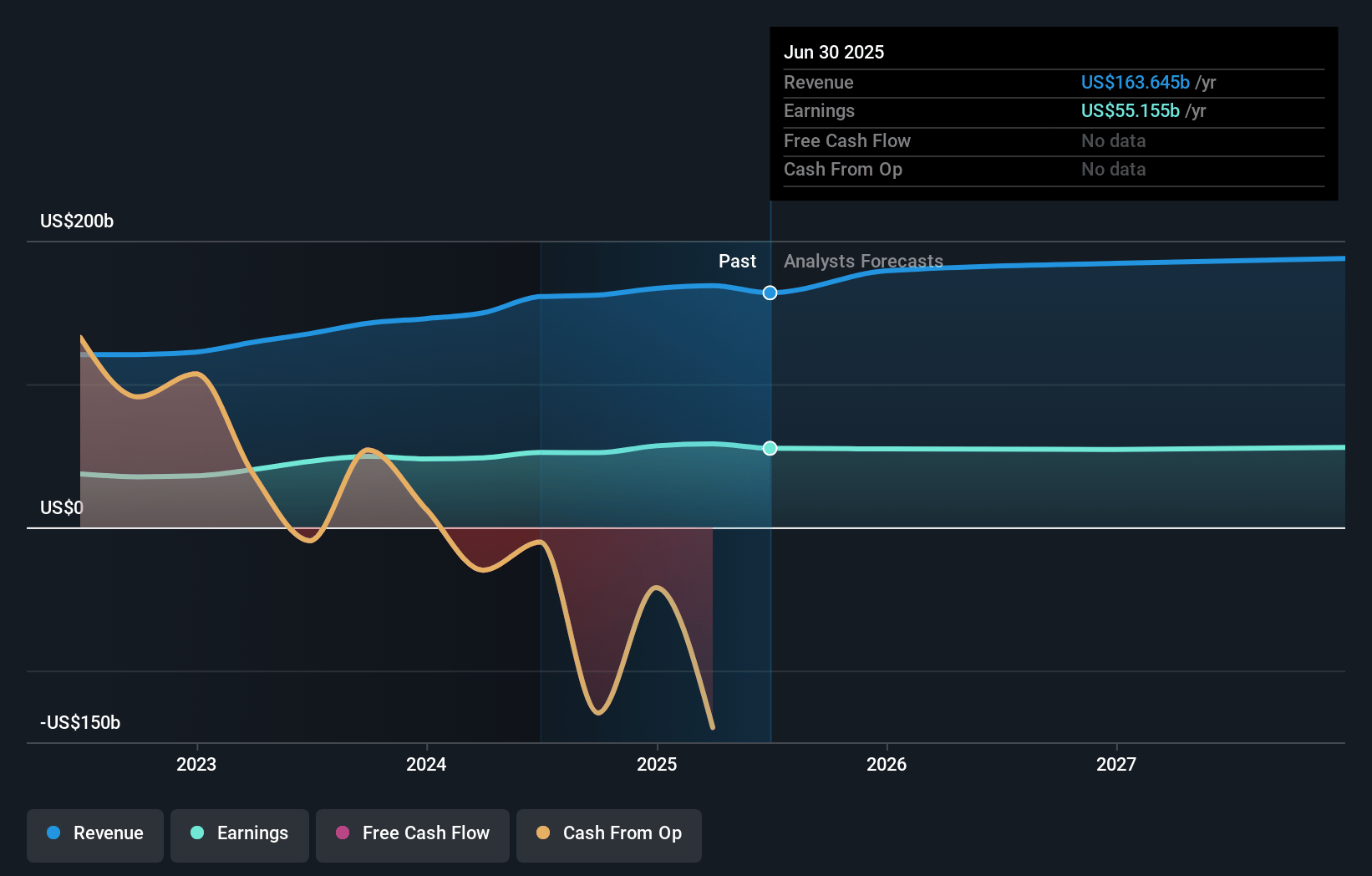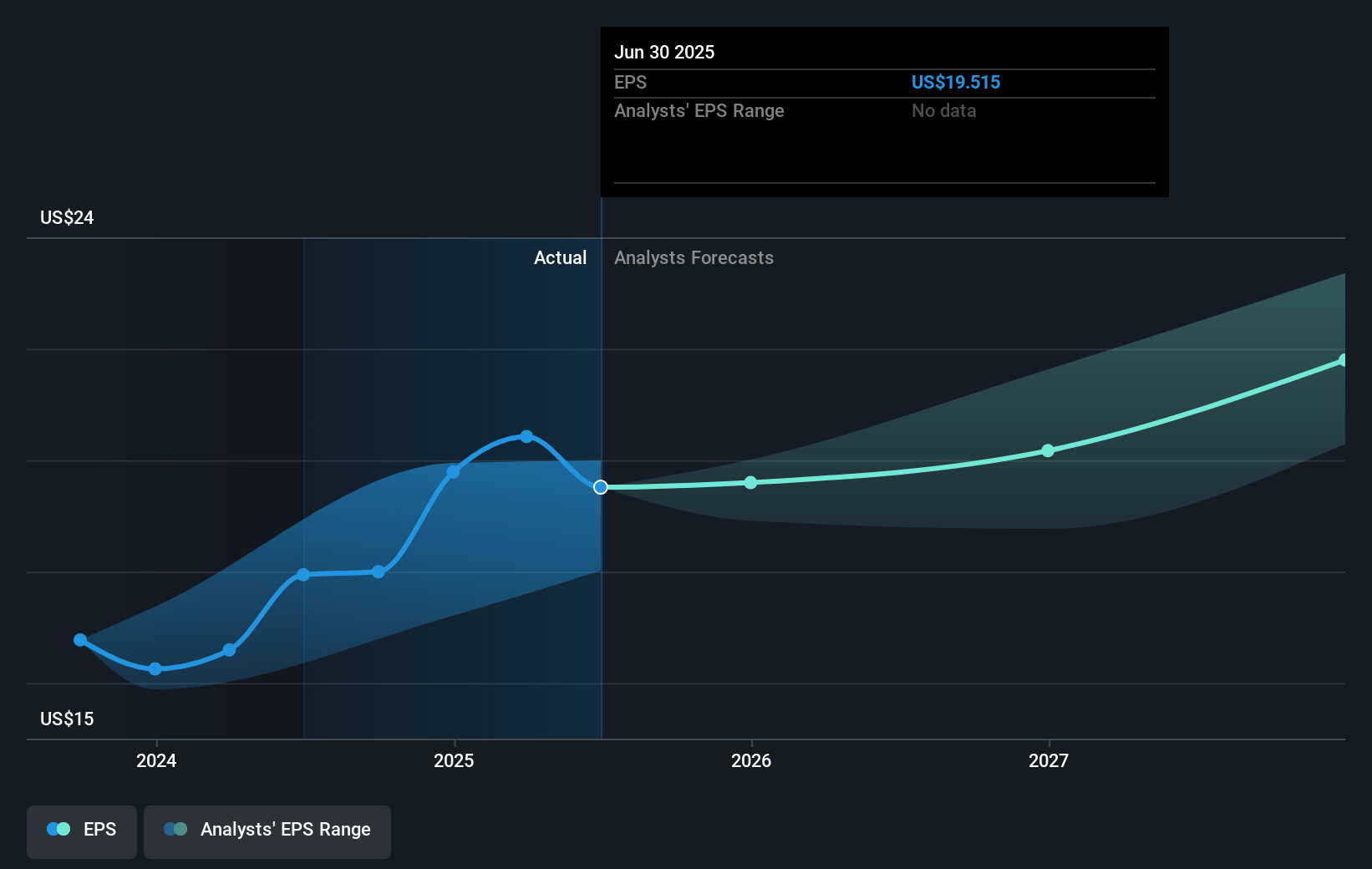Last Update07 May 25Fair value Decreased 14%
Key Takeaways
- Increased credit loss allowances and higher expenses signal challenges to net and operating margins, potentially straining future earnings.
- Anticipated rate cuts and cautious investment banking outlook could reduce net interest income and advisory revenue, impacting profitability.
- Strong growth across investment banking and asset management, combined with strategic tech investments, positions JPMorgan Chase for continued earnings and margin expansion.
Catalysts
About JPMorgan Chase- Operates as a financial services company worldwide.
- JPMorgan Chase's increase in allowance for credit losses to $27.6 billion, driven by heightened downside risks and elevated weighted average unemployment rate projections, suggests challenges ahead. This reflects potential strain on net margins as the bank prepares for more significant credit losses.
- The firm's higher expenses, which rose by 4% over the previous year to $23.6 billion, are largely attributed to increased compensation, marketing, and legal expenses. This indicates potential pressure on operating margins and could impact future earnings if revenue growth does not outpace expense growth.
- Increased reserve build, particularly in the consumer segment driven by macroeconomic changes, signals a cautious approach but could constrain net income growth if economic conditions deteriorate, impacting revenue streams dependent on consumer activity.
- JPMorgan's forward-looking guidance anticipates a reduction in net interest income due to expected rate cuts. This suggests a possible reduction in revenue as the net interest margin might decline with decreasing rates, affecting overall profitability.
- The cautious investment banking outlook, despite recent strength, reflects uncertainty in pipeline conversion due to elevated macroeconomic risks. This could result in lower advisory and underwriting fee revenue, impacting overall earnings if the market conditions remain unfavorable.
JPMorgan Chase Future Earnings and Revenue Growth
Assumptions
How have these above catalysts been quantified?- This narrative explores a more pessimistic perspective on JPMorgan Chase compared to the consensus, based on a Fair Value that aligns with the bearish cohort of analysts.
- The bearish analysts are assuming JPMorgan Chase's revenue will decrease by 0.8% annually over the next 3 years.
- The bearish analysts assume that profit margins will shrink from 34.5% today to 27.5% in 3 years time.
- The bearish analysts expect earnings to reach $47.5 billion (and earnings per share of $18.73) by about May 2028, down from $58.2 billion today. The analysts are largely in agreement about this estimate.
- In order for the above numbers to justify the price target of the more bearish analyst cohort, the company would need to trade at a PE ratio of 12.8x on those 2028 earnings, up from 11.9x today. This future PE is greater than the current PE for the US Banks industry at 11.0x.
- Analysts expect the number of shares outstanding to decline by 3.22% per year for the next 3 years.
- To value all of this in today's terms, we will use a discount rate of 7.31%, as per the Simply Wall St company report.
JPMorgan Chase Future Earnings Per Share Growth
Risks
What could happen that would invalidate this narrative?- JPMorgan Chase reported a significant increase in revenue and net income, with the first quarter of 2025 showing a net income of 14.6 billion dollars on revenue of 46 billion dollars, which suggests a strong revenue growth that may counter a downward trend in share price.
- The company's investment banking sector demonstrated robust growth, with debt underwriting fees increasing by 16% and a strong performance in advisory fees, supporting earnings.
- The Asset and Wealth Management division showed significant year-on-year growth in revenue driven by strong net inflows and a 15% increase in assets under management, contributing positively to net margins.
- JP Morgan's Markets division experienced a record 21% revenue increase due to robust performance in equities and better performance in fixed income, which supports stronger earnings potential.
- The firm continues to focus on strategic investments such as technology and AI, with a strong capital position indicated by 30 to 60 billion dollars in excess capital, which can reflect positively on future revenue streams and net margins.
Valuation
How have all the factors above been brought together to estimate a fair value?- The assumed bearish price target for JPMorgan Chase is $195.37, which represents two standard deviations below the consensus price target of $258.2. This valuation is based on what can be assumed as the expectations of JPMorgan Chase's future earnings growth, profit margins and other risk factors from analysts on the more bearish end of the spectrum.
- However, there is a degree of disagreement amongst analysts, with the most bullish reporting a price target of $330.0, and the most bearish reporting a price target of just $195.0.
- In order for you to agree with the bearish analysts, you'd need to believe that by 2028, revenues will be $172.7 billion, earnings will come to $47.5 billion, and it would be trading on a PE ratio of 12.8x, assuming you use a discount rate of 7.3%.
- Given the current share price of $249.39, the bearish analyst price target of $195.37 is 27.7% lower.
- We always encourage you to reach your own conclusions though. So sense check these analyst numbers against your own assumptions and expectations based on your understanding of the business and what you believe is probable.
How well do narratives help inform your perspective?
Disclaimer
AnalystLowTarget is a tool utilizing a Large Language Model (LLM) that ingests data on consensus price targets, forecasted revenue and earnings figures, as well as the transcripts of earnings calls to produce qualitative analysis. The narratives produced by AnalystLowTarget are general in nature and are based solely on analyst data and publicly-available material published by the respective companies. These scenarios are not indicative of the company's future performance and are exploratory in nature. Simply Wall St has no position in the company(s) mentioned. Simply Wall St may provide the securities issuer or related entities with website advertising services for a fee, on an arm's length basis. These relationships have no impact on the way we conduct our business, the content we host, or how our content is served to users. The price targets and estimates used are consensus data, and do not constitute a recommendation to buy or sell any stock, and they do not take account of your objectives, or your financial situation. Note that AnalystLowTarget's analysis may not factor in the latest price-sensitive company announcements or qualitative material.
Read more narratives











